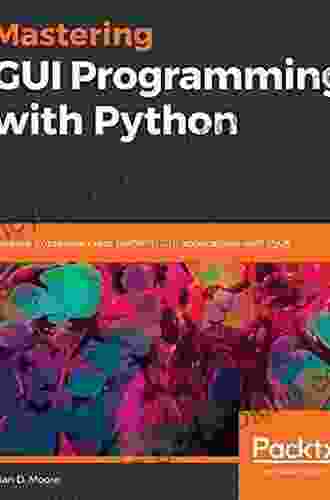Develop Impressive Cross-Platform GUI Applications with PyQt: A Comprehensive Guide

In the realm of software development, building user interfaces (UIs) that provide an engaging and consistent experience across different platforms is crucial. PyQt, an open-source Python-based framework, empowers developers to create stunning graphical user interfaces (GUIs) that seamlessly adapt to various operating systems, including Windows, macOS, and Linux.
4.3 out of 5
| Language | : | English |
| Text-to-Speech | : | Enabled |
| Enhanced typesetting | : | Enabled |
| Print length | : | 1067 pages |
| File size | : | 4277 KB |
| Screen Reader | : | Supported |
This comprehensive guide will delve into the fundamentals of PyQt, providing an in-depth exploration of its capabilities and guiding you through the process of developing cross-platform GUI applications with ease. Whether you're a seasoned PyQt developer or just starting your journey in this exciting field, this guide will illuminate the path to creating exceptional GUI applications.
Why Choose PyQt for Cross-Platform GUI Development?
PyQt stands out as a compelling choice for cross-platform GUI development for several reasons:
- Cross-Platform Compatibility: PyQt allows you to write code once and deploy your applications on different platforms without the need for platform-specific modifications.
- Native Look and Feel: PyQt seamlessly integrates with the underlying operating system, ensuring that your applications maintain a native look and feel, enhancing user experience and acceptance.
- Extensive Widget Library: PyQt provides a comprehensive widget library that encompasses a vast array of UI elements, such as buttons, labels, and menus, empowering you to create feature-rich and visually appealing applications.
- Open Source and Community Support: PyQt is open source and backed by a vibrant community, which ensures continuous development, regular updates, and extensive documentation, fostering collaboration and knowledge exchange.
li>Python-Based: PyQt leverages the power of Python, a highly readable and beginner-friendly programming language, which simplifies the development process and makes it accessible to a wide range of developers.
Getting Started with PyQt
To embark on your PyQt journey, follow these simple steps:
- Install PyQt: Begin by installing PyQt on your system using the appropriate package manager for your operating system.
- Create a PyQt Project: Use a Python IDE or a text editor to create a new PyQt project and configure it with the necessary imports.
- Design the User Interface: Employ PyQt's Qt Designer tool to visually design your user interface, or manually create the UI using PyQt code.
- Implement Application Logic: Add functionality to your application by connecting PyQt signals to Python slots and defining event handlers.
- Test and Deploy: Rigorously test your application to ensure it meets your requirements, and then deploy it to the target platforms.
Building a PyQt GUI Application
Let's delve into the process of building a simple PyQt GUI application that showcases its capabilities:
1. User Interface Design
Using Qt Designer, create a simple user interface consisting of a window with a label that displays "Hello, PyQt!".
2. Python Code
Create a Python file for your application and import the necessary PyQt modules. Define a main window class that inherits from PyQt's QMainWindow and implement the __init__() method to set up the application window and its contents.
python import sys from PyQt5.QtWidgets import QApplication, QMainWindow, QLabel
class MainWindow(QMainWindow): def __init__(self): super().__init__()
self.setWindowTitle("PyQt Example") self.setGeometry(100, 100, 250, 150)
label = QLabel("Hello, PyQt!", self) label.setAlignment(Qt.AlignCenter)
self.setCentralWidget(label)
3. Event Handling
Connect the close button's clicked signal to a Python slot that exits the application.
python self.close_button.clicked.connect(self.close)
4. Application Entry Point
Define the application's entry point by creating an instance of QApplication and the main window class, then executing the main loop.
python if __name__ =="__main__": app = QApplication(sys.argv) window = MainWindow() window.show() sys.exit(app.exec_())
PyQt opens up a world of possibilities for cross-platform GUI development. With its robust widget library, native look and feel, and ease of use, PyQt empowers you to create stunning and engaging applications that seamlessly adapt to different platforms. Whether you're building complex enterprise software or simple desktop utilities, PyQt provides the tools and flexibility you need to succeed.
Embark on your PyQt journey today and unlock the full potential of cross-platform GUI development. The resources and community support available will guide you every step of the way, empowering you to develop impressive and user-centric applications that transcend platform boundaries.
4.3 out of 5
| Language | : | English |
| Text-to-Speech | : | Enabled |
| Enhanced typesetting | : | Enabled |
| Print length | : | 1067 pages |
| File size | : | 4277 KB |
| Screen Reader | : | Supported |
Do you want to contribute by writing guest posts on this blog?
Please contact us and send us a resume of previous articles that you have written.
 Book
Book Novel
Novel Page
Page Chapter
Chapter Text
Text Story
Story Genre
Genre Reader
Reader Library
Library Paperback
Paperback E-book
E-book Magazine
Magazine Newspaper
Newspaper Paragraph
Paragraph Sentence
Sentence Bookmark
Bookmark Shelf
Shelf Glossary
Glossary Bibliography
Bibliography Foreword
Foreword Preface
Preface Synopsis
Synopsis Annotation
Annotation Footnote
Footnote Manuscript
Manuscript Scroll
Scroll Codex
Codex Tome
Tome Bestseller
Bestseller Classics
Classics Library card
Library card Narrative
Narrative Biography
Biography Autobiography
Autobiography Memoir
Memoir Reference
Reference Encyclopedia
Encyclopedia Abbas Kazerooni
Abbas Kazerooni A K Duboff
A K Duboff Alec Potrero
Alec Potrero Alan Rusbridger
Alan Rusbridger Alex Hillkurtz
Alex Hillkurtz Alex Bezzerides
Alex Bezzerides Abby Linwood
Abby Linwood Aaron Tesfaye
Aaron Tesfaye Albert Marrin
Albert Marrin Abby Whiteside
Abby Whiteside Adele P Margolis
Adele P Margolis Al Barkow
Al Barkow A J Rivers
A J Rivers Al Berenger
Al Berenger 3rd Edition Kindle Edition
3rd Edition Kindle Edition Alex Albrinck
Alex Albrinck Alan S Kaufman
Alan S Kaufman Aayush Upadhyay
Aayush Upadhyay Aaron Pribble
Aaron Pribble Aastha Miranpuri
Aastha Miranpuri
Light bulbAdvertise smarter! Our strategic ad space ensures maximum exposure. Reserve your spot today!

 Joseph HellerThe Boy Who Biked The World: An Unforgettable Journey of Courage, Adventure,...
Joseph HellerThe Boy Who Biked The World: An Unforgettable Journey of Courage, Adventure,... Doug PriceFollow ·19.4k
Doug PriceFollow ·19.4k Joel MitchellFollow ·5.8k
Joel MitchellFollow ·5.8k Art MitchellFollow ·18k
Art MitchellFollow ·18k Branden SimmonsFollow ·16.7k
Branden SimmonsFollow ·16.7k Ezekiel CoxFollow ·19.7k
Ezekiel CoxFollow ·19.7k Thomas PowellFollow ·15.8k
Thomas PowellFollow ·15.8k Dwight BlairFollow ·4.3k
Dwight BlairFollow ·4.3k Jarrett BlairFollow ·13.7k
Jarrett BlairFollow ·13.7k

 Francis Turner
Francis TurnerArt and Politics in the Shadow of Music
Music has...

 Jaylen Mitchell
Jaylen MitchellHow Algorithms Are Rewriting The Rules Of Work
The workplace is...

 Chandler Ward
Chandler WardRio de Janeiro & Minas Gerais Footprint Handbooks:...
Embark on an extraordinary adventure through...

 David Mitchell
David MitchellThe Story of Depression: Understanding and Treating a...
Delving into the Shadows of...

 Al Foster
Al FosterStatistics Done Wrong: The Woefully Complete Guide
Tired of being...

 DeShawn Powell
DeShawn PowellJulia Child's Second Act: A Tale of Triumph,...
Julia Child is an...
4.3 out of 5
| Language | : | English |
| Text-to-Speech | : | Enabled |
| Enhanced typesetting | : | Enabled |
| Print length | : | 1067 pages |
| File size | : | 4277 KB |
| Screen Reader | : | Supported |










